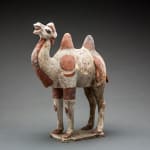Tang Sculpture of a Camel, 618 CE - 906 CE
Terracotta
33 x 25.4 cm
13 x 10 in
13 x 10 in
TF.020
Further images
Large, free-standing terracotta Bactrian camel with traces of original slip; walking with left legs out in front; broad, curved body with twin humps rises through thick neck with stylised mane...
Large, free-standing terracotta Bactrian camel with traces of original slip; walking with left legs out in front; broad, curved body with twin humps rises through thick neck with stylised mane to small, narrow head with wide eyes, flaring nostrils and open, braying mouth; laden with heavy pack; tall, undulated tail. The Silk Road refers to a 5,000-mile system of trade routes that linked the eastern Mediterranean region to Central and East Asia. At its zenith the Silk Route was the longest road in the world. Merchants traveling in caravans across the route’s wide expanse carried prized commodities like silk, tea, and jade from China, often exchanging them with other traders for gunpowder, paper, and glassware from the West. The main form of transportation in the caravans was camels – or “Ships of the Night” as they were known. Camels were a key part of the success of these trade passages for despite their time-consuming training and high cost, they could carry more weight, walk on terrains more efficiently and needed less water than any other animal. This piece would have formed part of a retinue of objects buried with the deceased. Burial figurines (mingqi) worked in concert with other tomb objects to support a larger funerary agenda, the goal of which was to comfort and satisfy the deceased, who in this case must have been a person of good means given the expense of commissioning such an object – perhaps, an aristocrat, high-ranking officer or wealthy merchant. The variety of goods on its packsaddle boards between the characteristic twin humps of the Bactrian camel symbolizes prosperity and would have commanded a lot of respect.





